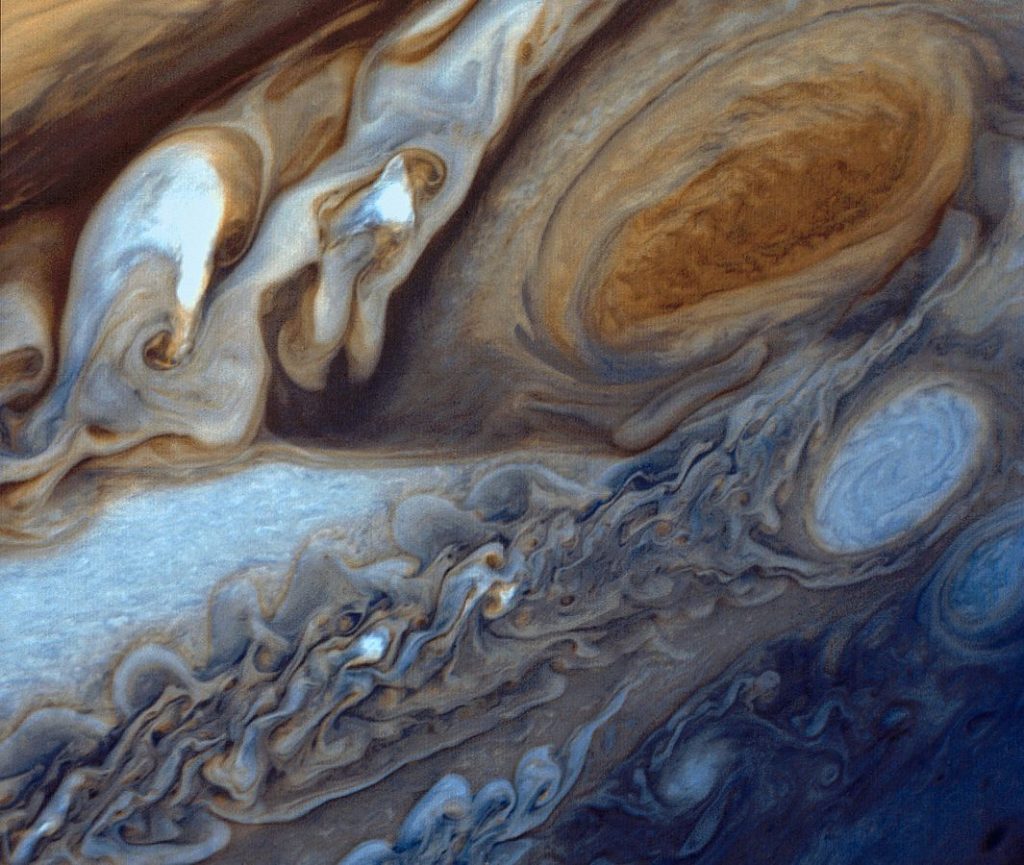
Source: https://www.smithsonianmag.com/smart-news/jupiters-great-red-spot-also-red-hot-180959949/
Jupiter’s Great Red Spot Is Also Red Hot
Jupiter’s Great Red Spot is the gas giant’s most defining feature. A swirling storm of gas that has whirled for hundreds of years, the Spot is also the source of some of the planet’s deepest mysteries. Now, thanks to new research published in the journal Nature, one of those mysteries may have been solved.
When the NASA probe Pioneer 10 passed by Jupiter in 1973, it sent scientists back some puzzling readings taken from the planet’s upper atmosphere. The planet’s temperature was much hotter than they guessed it would be. Until then, most planetary researchers believed that Jupiter’s upper reaches would be pretty cold, considering how far the gas giant is from the sun’s warming rays. But instead of the brisk -100 degrees Fahrenheit that they expected, Pioneer 10 reported that Jupiter’s atmosphere actually hovered around 1,000 degrees, Kenneth Chang reports for the New York Times. “Essentially there’s a bit of a crisis going on,” Boston University researcher and study author James O’Donoghue tells Chang. “That highlights a severe lack of knowledge.” In fact, over the years, the problem was nicknamed Jupiter’s “energy crisis” because of the vast difference between the energy the planet needed to stay so hot and what scientists had theorized. And Jupiter isn’t the only planet with this problem: scientists have had trouble explaining why other gas giants are so toasty too, Becky Ferreira reports for Motherboard. “For all of these [gas giant] planets, we have a problem explaining why their upper atmospheres are as hot as they are,” Luke Moore, a Boston University research scientist and the study’s co-author, tells Ferreira. “Anytime there’s a problem that we can’t explain, it implies that there is some missing understanding in our science of these planets.” While scientists have proposed all kinds of ideas, such as Jupiter’s polar aurorae may help heat up the planet, so far most of them have had some fatal flaw. Now it seems, however, that the missing puzzle piece may have been found. Using temperature data gathered from the NASA Infrared Telescope Facility in Hawaii, O’Donoghue and Moore discovered that the Great Red Spot is more than twice as hot than the average temperatures found throughout the rest of Jupiter’s atmosphere. Broiling at more than 2,400 degrees Fahrenheit, the researchers believe that the Great Red Spot may be partially responsible for heating up the entire all gas giant, Loren Grush reports for The Verge. The key may come from the Spot’s gales, which blow at speeds of up to 400 miles per hour. With that much turbulence, it would also be pretty loud, generating sound waves that shoot upward and rattle the atoms in the upper atmosphere. That would give even the farthest reaches of Jupiter’s atmosphere an extra energy boost, helping it stay hot, Grush reports. “A good analogy for this is it’s pretty much like stirring a cup of coffee with a spoon,” O’Donoghue tells Grush. “If you’re stirring it clockwise, but then you suddenly stir it anti-clockwise, there will be a lot of sloshing around… And that sloshing around, you can actually hear that. It indicates there are actually some sound waves coming from that sloshing.” These new findings not only provide new evidence for why Jupiter is so warm, but suggests that the upper and lower regions of its atmosphere are much more interconnected than scientists once thought. With this new data in hand, the researchers are now looking at other smaller Jovian storms to see whether the same thing happens there, too. With NASA’s Juno spacecraft finally in orbit around the gas giant after years of flying through space, Jupiter may not stay quite so mysterious for long.